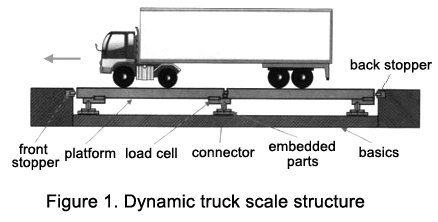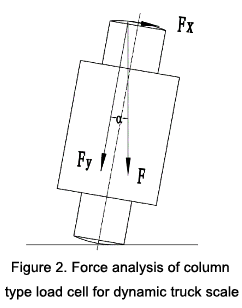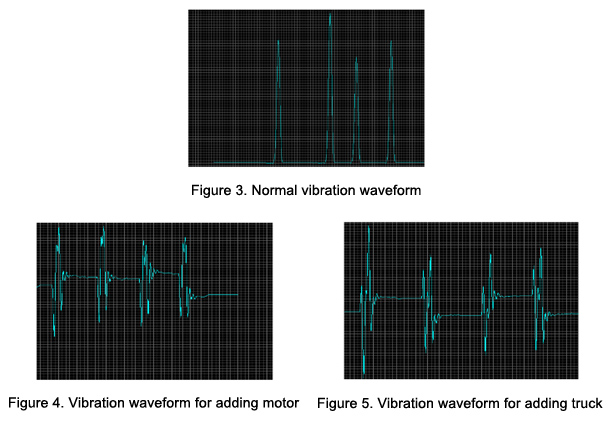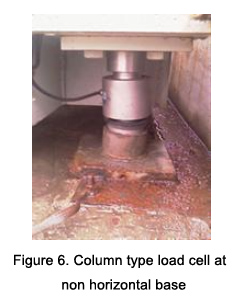Load Cell Selection for ETC Dynamic Truck Scale
For large truck electronic toll collection (ETC) system, the key technology is weighing, while the key equipment for weighing is dynamic truck scale. Dynamic truck scale is developed from static truck scale, the main load cells it uses are column type load cells and beam load cells. Someone believe that choosing column type load cells can have high response frequency and weighing accuracy, while others think choosing beam load cells can provide stable precision and is easy for installation.
The merits and demerits of column type load cell and beam load cell have been debated endlessly, but how to select the column type load cell and beam load cell? This article will focus on analyzing this problem.
I. Weighing Process of Dynamic Truck Scale
When a truck drives on the dynamic truck scale (hereinafter referred to as the scale), the scale is pushed forward by the inertial force of the front wheel. As the scale moves to the front stopper, the stopper generates a backward thrust to push the scale back. The reaction thrust produced as the scale moves to the back stopper and the truck's driving force push the scale accelerate forwarding. Before the truck is fully reached on the scale, the scale will continue to accelerate oscillation, forming an accelerated oscillation phenomenon.

When the truck is fully reached on the scale, the driving force generated elsewhere gradually disappears. The front oscillation frequency speed of the scale will no longer accelerate. When the truck accelerates or decelerates, oscillation frequency of the scale also accelerates and decelerates correspondingly. In a word, a medium and low frequency oscillation forms before and when the truck reaches on the scale. Forces produced by the truck weight and other thrust vibration are transmitted to the load cell through the scale, and then the load cell transmits the force information to the instrument (computer) accurately and quickly for data processing, the results are finally shown on the weighing instrument.
II. Analysis of Load Cell Sampling Frequency
There are two types of load cell for dynamic truck scale: column type load cell and beam load cell.
1. Force analysis
Here is the force analysis diagram of column type load cell.


Truck speed, driving force, brake and other horizontal forces make the scale to swing left and right, and contact the stopper, resulting in backward thrust. As the speed and driving force are different, the backward thrust is also irregular, only data without knock on stopper are chosen for data processing. In this way, choose the truck vibration, motor vibration and other reverse regular fluctuations. We choose no less than 3 swings. We can obtain effective and ideal data, and then obtain the precision after data processing.
2. Calculate the sampling fluctuation time on the scale
The length of single scale is generally 6 meters, total length for 3 scales is 18 meters. Most trucks on the highway are semi-trailers at present. The distance between its front wheels and rear wheels is about 15m, 18m-15m=3m. Truck speed on the scale is about 20km/h, 3m/20km/h=0.54s.
Less than 3 swings are chosen, the acquisition time is 2/3 of one cycle, than 0.54/3*(2/3)=0.12s, namely maximum acquisition time per cycle is 0.12 seconds. 10 data would be selected for each waveform (5 for front swing and 5 for back swing), then the sampling time for each one is 0.012s (83Hz).
Therefore, we can get effective data when the natural frequency of the load cell is about 83-100Hz. In order to improve the precision of scale, current acquisition frequency of the scale is generally 1000 Hz, that is, 1000 data per second.
On the scale, sampling frequency of the load cell is about column type load cell natural frequency > 10000 Hz, and beam load cell natural frequency > 1000 Hz.
3. Load cell sampling frequency analysis
Just according to the natural frequency of these two kinds of load cell, it's undoubtedly that the natural frequency of column type load cell is higher than that of the beam load cell. However, the scale is composed of the scale body, load cells and weighing instrument, its response speed is the ultimate determinant of performance. Response speed of the scale is jointly determined by the scale's response speed, the instrument's response speed and the load cell's response speed.
With the rapid development of electronic technology, it has no longer been difficult to manufacture instruments with high resolution and high response speed, but it's indeed difficult to improve the response speed of the scale. At present, the scale structure and material used by various manufacturers are nearly the same. According to the data, natural frequency of the scale body is usually 3-5Hz, and it can't be further improved. Therefore, both load cells can meet the requirements from the perspective of sampling frequency.
III. Analysis of Load Cell Installation
The advantages and disadvantages of column type load cell and beam load cell are compared as follows:
1. Column type load cell
2. Beam load cell
IV. Conclusion
Based the above analysis, we can draw the following conclusions: among the dynamic scales of 20 km/h, there is no essential difference between the beam load cell and the column type load cells in the acquisition speed, both of them can be used normally. In terms of impact resistance, the beam load cell is superior than the column type load cell. In terms of installation conditions, the beam load cell is far easier than the column type load cell. When applying the dynamic scale, customers can choose a beam load cell or column type load cell according to the situation on site.
The merits and demerits of column type load cell and beam load cell have been debated endlessly, but how to select the column type load cell and beam load cell? This article will focus on analyzing this problem.
I. Weighing Process of Dynamic Truck Scale
When a truck drives on the dynamic truck scale (hereinafter referred to as the scale), the scale is pushed forward by the inertial force of the front wheel. As the scale moves to the front stopper, the stopper generates a backward thrust to push the scale back. The reaction thrust produced as the scale moves to the back stopper and the truck's driving force push the scale accelerate forwarding. Before the truck is fully reached on the scale, the scale will continue to accelerate oscillation, forming an accelerated oscillation phenomenon.

When the truck is fully reached on the scale, the driving force generated elsewhere gradually disappears. The front oscillation frequency speed of the scale will no longer accelerate. When the truck accelerates or decelerates, oscillation frequency of the scale also accelerates and decelerates correspondingly. In a word, a medium and low frequency oscillation forms before and when the truck reaches on the scale. Forces produced by the truck weight and other thrust vibration are transmitted to the load cell through the scale, and then the load cell transmits the force information to the instrument (computer) accurately and quickly for data processing, the results are finally shown on the weighing instrument.
II. Analysis of Load Cell Sampling Frequency
There are two types of load cell for dynamic truck scale: column type load cell and beam load cell.
1. Force analysis
Here is the force analysis diagram of column type load cell.

- When scale contacts with front stopper, load cell suffere by axial force F=Fy×cosα°+Fx×sinα°.
-
When scale doesn't contact with front stopper, F changes from F=Fy×cosα° to F=Fy×cos0°.

Truck speed, driving force, brake and other horizontal forces make the scale to swing left and right, and contact the stopper, resulting in backward thrust. As the speed and driving force are different, the backward thrust is also irregular, only data without knock on stopper are chosen for data processing. In this way, choose the truck vibration, motor vibration and other reverse regular fluctuations. We choose no less than 3 swings. We can obtain effective and ideal data, and then obtain the precision after data processing.
2. Calculate the sampling fluctuation time on the scale
The length of single scale is generally 6 meters, total length for 3 scales is 18 meters. Most trucks on the highway are semi-trailers at present. The distance between its front wheels and rear wheels is about 15m, 18m-15m=3m. Truck speed on the scale is about 20km/h, 3m/20km/h=0.54s.
Less than 3 swings are chosen, the acquisition time is 2/3 of one cycle, than 0.54/3*(2/3)=0.12s, namely maximum acquisition time per cycle is 0.12 seconds. 10 data would be selected for each waveform (5 for front swing and 5 for back swing), then the sampling time for each one is 0.012s (83Hz).
Therefore, we can get effective data when the natural frequency of the load cell is about 83-100Hz. In order to improve the precision of scale, current acquisition frequency of the scale is generally 1000 Hz, that is, 1000 data per second.
On the scale, sampling frequency of the load cell is about column type load cell natural frequency > 10000 Hz, and beam load cell natural frequency > 1000 Hz.
3. Load cell sampling frequency analysis
Just according to the natural frequency of these two kinds of load cell, it's undoubtedly that the natural frequency of column type load cell is higher than that of the beam load cell. However, the scale is composed of the scale body, load cells and weighing instrument, its response speed is the ultimate determinant of performance. Response speed of the scale is jointly determined by the scale's response speed, the instrument's response speed and the load cell's response speed.
With the rapid development of electronic technology, it has no longer been difficult to manufacture instruments with high resolution and high response speed, but it's indeed difficult to improve the response speed of the scale. At present, the scale structure and material used by various manufacturers are nearly the same. According to the data, natural frequency of the scale body is usually 3-5Hz, and it can't be further improved. Therefore, both load cells can meet the requirements from the perspective of sampling frequency.
III. Analysis of Load Cell Installation
The advantages and disadvantages of column type load cell and beam load cell are compared as follows:
1. Column type load cell
- Advantages: Compact structure and small size, high natural frequency and fast dynamic response.
- Disadvantages: Poor lateral and eccentric load resistance, sensitive to change of loading point, high installation requirements, tedious adjustment operation, the load cell is not easy to fix but easy to rotate, excessive loading frequency or weight would easily lead to load cell cracking.
-
Cause analysis: Reasons for the rotation of tumbler. When the column type load cell is vertical at a horizontal base, it will not rotate no matter how it swings. But when the base is not horizontal, offset and rotation occurs.

2. Beam load cell
- Advantages: Insensitive to change of loading point, good anti-eccentric load performance, good inherent linearity, easy installation, the load cell is fixed and not rotated, and the manufacturing cost is low.
-
Disadvantages: Large size and weight, difficult to move.
IV. Conclusion
Based the above analysis, we can draw the following conclusions: among the dynamic scales of 20 km/h, there is no essential difference between the beam load cell and the column type load cells in the acquisition speed, both of them can be used normally. In terms of impact resistance, the beam load cell is superior than the column type load cell. In terms of installation conditions, the beam load cell is far easier than the column type load cell. When applying the dynamic scale, customers can choose a beam load cell or column type load cell according to the situation on site.

